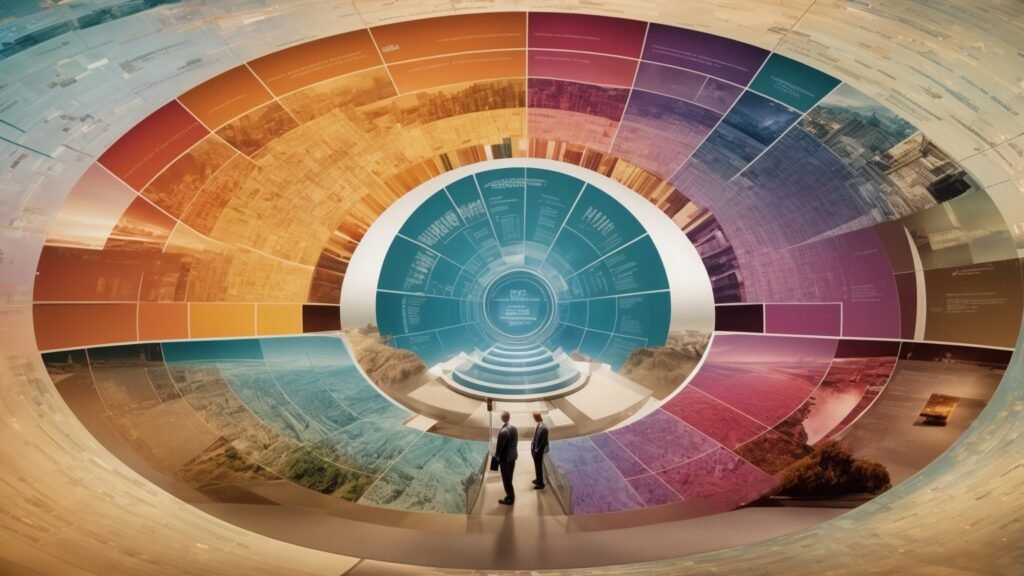Estimated reading time: 21 minutes
Introduction
In the ever-evolving digital marketing landscape, the role of Management Information Systems (MIS) has become increasingly pivotal. These systems integrate essential functions such as data collection, data processing, and information dissemination to enhance decision-making and strategic planning. At the core of this integration is the MIS system, which utilizes computer systems and business information to streamline operations and boost efficiency across various organizational levels.
Moreover, MIS professionals are tasked with harnessing information technologies to tailor these systems to meet specific business information systems needs. This customization is crucial in fields like digital marketing where precision and adaptability can greatly influence a company’s competitive edge. Effective MIS systems are also integral in ensuring information security, optimizing database management, and facilitating a solid foundation for those seeking a career in MIS. Utilizing hardware and software designed to handle and interpret vast amounts of data, MIS systems provide the useful information necessary for informed decision-making and operational agility.
Key Takeaways
- Management Information Systems (MIS) are essential for integrating data collection, processing, and dissemination, optimizing efficiency in digital marketing strategies and decision-making.
- The adaptability and scalability of MIS systems are crucial for maintaining competitive advantage in the dynamic digital marketing environment.
- Effective MIS systems ensure data accuracy and accessibility, which are critical for informed decision-making across all organizational levels.
- Customization of MIS is key to addressing unique business challenges and enhancing operational efficiency in diverse business models.
- Software components in MIS play a transformative role by enabling efficient data analysis and strategic decision-making in digital marketing.
- The hierarchical structure of MIS ensures the appropriate flow of information across different management levels, aligning with strategic business needs.
Characteristics of MIS System: A Deep Dive
Defining MIS and its Importance
Management Information Systems (MIS) have become the backbone of modern business operations, integrating data processing and information systems to streamline and optimize decision-making processes. At its core, an MIS is designed to manage and interpret vast amounts of data, turning it into actionable insights for strategic planning. The significance of MIS in today’s business environment cannot be overstated, especially in realms like digital marketing and content creation, where data-driven decisions are paramount.
Core Components of an MIS System
MIS systems comprise several vital components that work synergistically:
- Data Collection: The systematic gathering of relevant data from various sources.
- Data Storage: Efficiently storing collected data for easy retrieval and analysis.
- Data Management: Organizing and maintaining the data to ensure its relevance and accuracy.
- Data Analysis: Interpreting the data to extract meaningful insights and trends.
- Information Dissemination: Sharing the processed information with relevant stakeholders for informed decision-making.
Ensuring Data Accuracy and Accessibility in MIS System
The cornerstone of any effective MIS is the accuracy and accessibility of its data. Inaccurate data can lead to misguided strategies, particularly in fields like content marketing and digital advertising, where precision is crucial. An MIS must have robust validation and verification processes to ensure data integrity. Additionally, data accessibility is vital. Regardless of their technical prowess, stakeholders should be able to access and understand the information provided by the system. This democratization of data empowers all levels of an organization to make informed decisions.
Customizing MIS System to Fit Diverse Business Models
Every business has unique needs and challenges; thus, a one-size-fits-all approach to MIS is not feasible. Customizing MIS to fit specific business models is essential. Whether it’s a B2B digital marketing agency or a retail giant, the MIS should be tailored to align with the business’s strategic goals and operational demands. A well-customized MIS improves efficiency and enhances the effectiveness of business processes.
“The true power of an MIS lies in its customization. Tailored systems turn raw data into a strategic asset.” – Izzy Jane, MIS Expert
The Impact of MIS System on Business Efficiency
A well-implemented MIS can significantly enhance business efficiency. Providing timely and accurate information enables businesses to respond rapidly to market changes, understand customer needs better, and streamline internal processes. In areas like content creation and digital marketing, this means quickly adjusting strategies in response to consumer behavior or market trends, thereby maximizing the impact of marketing efforts.
The characteristics of an effective MIS system – from its ability to collect and analyze data accurately to its customization for specific business needs – play a critical role in enhancing business efficiency and decision-making. As businesses continue to navigate the complexities of the digital age, the role of MIS in driving success becomes increasingly evident.

The Role of Software in Enhancing MIS System
Importance of Software in MIS System
In the intricate world of Management Information Systems (MIS), software emerges as a critical component, acting as the driving force that empowers these systems. Software in MIS is more than just a tool; it’s a catalyst that transforms raw data into strategic insights, facilitating smarter business decisions. In an era where digital marketing strategies and content creation rely heavily on data analytics, the software component of MIS becomes indispensable for its ability to process and analyze data efficiently and accurately.
Popular MIS Software Solutions
Several software solutions have gained prominence in the realm of MIS, each offering unique features and capabilities:
- SAP Business Intelligence: Known for its comprehensive data analysis and reporting tools.
- Oracle NetSuite: A versatile solution offering integrated business management features.
- Microsoft Dynamics: Renowned for its customer relationship management (CRM) capabilities.
- Tableau: A leading tool for data visualization and business intelligence.
- IBM Cognos Analytics: Offers advanced analytics and detailed data insights.
Evaluating Software Impact on MIS System
The impact of software on MIS is profound and multifaceted. It enhances the overall efficiency of MIS by automating complex data processing tasks, thereby reducing the margin for human error. Moreover, advanced software solutions incorporate artificial intelligence (AI) and machine learning algorithms, enabling predictive analytics and trend forecasting. This capability is particularly beneficial in digital marketing, where understanding future trends is vital to strategic planning.
Comparison of Different MIS Software
| Software Solution | Key Features | Best For |
|---|---|---|
| SAP Business Intelligence | Advanced analytics, reporting | Large-scale enterprises |
| Oracle NetSuite | Integrated business management | Mid to large businesses |
| Microsoft Dynamics | CRM, ERP solutions | Customer-focused businesses |
| Tableau | Data visualization, BI | Data-driven decision-making |
| IBM Cognos Analytics | Detailed data insights, AI | Complex data analysis |
Integration Challenges and Solutions
While software significantly enhances MIS, integrating new software into existing systems can pose challenges. These challenges range from technical compatibility issues to employee training requirements. Effective integration strategies often involve phased implementation, gradually introducing new software. Additionally, providing comprehensive training and support to employees ensures a smooth transition and maximizes the software’s utility.
The role of software in enhancing MIS is undeniable. It provides the tools for efficient data processing, insightful analytics, and strategic decision-making. As businesses continue to navigate the complexities of the digital landscape, choosing and integrating the right software solutions into their MIS will play a pivotal role in their success, particularly in areas like digital marketing and content management.
Hierarchical Structure of MIS: A Strategic Overview
Overview of MIS System Hierarchy
The hierarchical structure of Management Information Systems (MIS) is a fundamental aspect that determines how information flows within an organization. This structure is pivotal in ensuring that the correct information reaches the appropriate levels of management at the right time, thereby facilitating informed decision-making. A well-designed MIS hierarchy aligns with the organization’s structure, mirroring its levels of authority and information needs. This alignment is crucial for optimizing operational efficiency and strategic planning, particularly in sectors where data-driven decisions are vital, such as digital marketing and content creation.
Case Study: Consider the case of Google, a global leader in digital services and advertising. At the operational level, Google’s MIS provides granular data on user interactions, ad performance, and search trends. Middle management uses MIS to analyze market trends and develop targeted advertising strategies. The top management at Google utilizes MIS for strategic decision-making, such as new product development and market expansion plans. This structured approach to MIS ensures that each management level at Google receives tailored, actionable information, significantly contributing to the company’s market leadership and innovative edge.
Decision-Making at Different MIS System Levels
At each level of the MIS hierarchy, the nature and scope of decision-making vary significantly:
- Operational Level: Here, MIS provides detailed, day-to-day operational data. This level focuses on routine decisions, like adjusting digital ad campaigns based on real-time data.
- Middle Management Level: MIS at this level offers trend analysis and performance reports, aiding in short to medium-term strategic decisions, such as planning a content marketing strategy.
- Top Management Level: At this apex, MIS offers aggregated data and predictive analytics, aiding in long-term strategic decisions like entering new markets or adjusting overall business strategy.
Levels in MIS and Their Functions
- Operational Level: Handles daily transactions and operations.
Key function: Monitoring and controlling routine activities. - Middle Management Level: Focuses on tactical decision-making.
Key function: Short-term planning and performance analysis. - Top Management Level: Concerned with strategic decision-making.
Key function: Long-term planning and policy formulation.
Case Study: A notable example is the application of MIS hierarchy at Walmart, the world’s largest retailer. At the operational level, Walmart’s MIS manages vast data related to inventory, sales, and customer preferences. This data is crucial for ensuring the efficient operation of its numerous stores. Middle management at Walmart uses MIS for market analysis, managing supply chains, and tactical decision-making regarding store operations and promotions. At the top management level, MIS is instrumental in strategic decision-making, aiding in global expansion strategies, sustainability initiatives, and long-term corporate planning. This hierarchical MIS structure is a critical component of Walmart’s success, allowing for effective management of its extensive retail operations.
Future Trends in MIS System Hierarchy
The future of the MIS hierarchy is likely to be shaped by advancements in AI and machine learning. Predictive analytics and automated decision-support systems will be more significant, particularly at higher management levels. Integrating these technologies will enable more agile and sophisticated decision-making processes, aligning with the evolving dynamics of the business world, especially in rapidly changing sectors like digital marketing.
The hierarchical structure of MIS is a critical factor in effectively managing information across different levels of an organization. From operational to strategic levels, a well-structured MIS ensures that the correct information is delivered to the right people at the right time. As businesses continue to evolve, integrating advanced technologies in MIS will further enhance decision-making processes, making it an even more indispensable tool in business management and strategy.
Varieties of Management Information Systems
Different Types of MIS: Different Management Information Systems
Management Information Systems (MIS) come in various forms, each tailored to meet the unique needs of different organizations. From handling simple data processing tasks to complex predictive analytics, the spectrum of MIS types is broad and diverse. Understanding these varieties is crucial for organizations to select a system that aligns with their operational needs and strategic goals. This selection is essential in sectors where data drives core activities, such as digital marketing, content creation, and business analytics. Each type of MIS offers distinct features and capabilities, making them suitable for various business functions and management levels.
Types of MIS and Their Features
| Type of MIS | Key Features | Best Suited For |
|---|---|---|
| Transaction Processing Systems (TPS) | Fast processing of basic transactions, data collection | Operational management, routine tasks |
| Management Reporting Systems (MRS) | Regular reports, performance monitoring | Middle management, performance tracking |
| Decision Support Systems (DSS) | Analytics, decision-making tools | Decision-makers, strategic planning |
| Executive Information Systems (EIS) | High-level data summary, trend analysis | Top executives, strategic decision-making |
| Customer Relationship Management (CRM) Systems | Customer data management, interaction tracking | Sales and marketing departments |
| Supply Chain Management (SCM) Systems | Supply chain logistics, inventory management | Operations and logistics management |
Criteria for Choosing the Right MIS
Selecting the right MIS for an organization involves several critical factors:
- Business Needs and Objectives: The chosen MIS must align with the organization’s objectives and specific operational needs.
- Scalability: The system should be scalable to accommodate future growth and changes in the business environment.
- Integration Capability: An ideal MIS should seamlessly integrate with existing systems and processes.
- User-Friendliness: The system must be user-friendly to ensure smooth adoption by all employees.
- Cost-effectiveness: Budget constraints and return on investment should be considered to ensure cost-effectiveness.
- Data Security and Compliance: The system should offer robust data security features and comply with relevant data protection regulations.
“Selecting the right MIS is not just about the technology; it’s about finding a solution that breathes with the rhythm of your business.” – John Smith, MIS Consultant
The variety of Management Information Systems available today offers organizations various options depending on their specific needs and goals. From TPS for operational efficiency to EIS for strategic decision-making, each type of MIS serves a distinct purpose. The key to successfully leveraging an MIS lies in carefully assessing organizational requirements and choosing a system that best aligns with these needs while offering scalability, integration capability, user-friendliness, and cost-effectiveness. With the right MIS, organizations can significantly enhance their data management capabilities, improving decision-making and overall operational efficiency, especially in data-centric fields like digital marketing and business analytics.

The Evolutionary Journey of MIS Systems: Level Of Management Information Systems
The History of MIS Development
The development of Management Information Systems (MIS) has been a transformative journey, mirroring the evolution of technology and business needs over the decades. From its nascent stage in the early days of computer technology to its current role as a cornerstone in modern business strategy, MIS has undergone significant transformations. Tracing this history is fascinating and provides insights into how MIS has become an integral part of organizational decision-making, particularly in fields like digital marketing and business intelligence.
Key Milestones in MIS Evolution
- 1960s-1970s: Emergence and Initial Development – MIS began as simple information systems, primarily for data processing and basic reporting.
- 1980s: Integration of Personal Computers – The advent of PCs brought MIS to a broader range of businesses, enhancing data accessibility.
- 1990s: Internet and Networking Boom – Internet proliferation allowed MIS to connect with external data sources, vastly expanding its capabilities.
- 2000s: Advent of Big Data and Analytics – The explosion of big data and advanced analytics tools propelled MIS into a new era of data-driven decision-making.
- 2010s-Present: AI and Cloud Computing – Integrating artificial intelligence and cloud computing has significantly advanced MIS, making it more agile and intelligent.
Current Trends in MIS
The landscape of Management Information Systems (MIS) today is being reshaped by several pivotal trends, each playing a significant role in its evolution and increasing relevance in modern business. A key trend is Data Democratization, where MIS systems have become increasingly user-friendly, empowering even non-technical staff to access and interpret complex data. This shift is pivotal in fostering a data-driven culture within organizations. Another trend is the rise of Mobile Accessibility. With the ubiquity of smartphones, MIS systems have evolved to be accessible on mobile devices, making data management more flexible and on the go, catering to the needs of a mobile workforce.
Cloud-based Solutions represent another major trend. Many MIS are transitioning to cloud platforms, offering greater scalability, flexibility, and cost-efficiency than traditional on-premises systems. This shift to the cloud enables businesses to adapt more swiftly to market changes and scale their operations as needed. Furthermore, incorporating Predictive Analytics into MIS has become a standard, allowing companies to analyze current data, forecast future trends, and make proactive decisions. This capability is precious in digital marketing and strategic planning sectors, where anticipating market dynamics can provide a competitive edge.
Lastly, a strong focus on Cybersecurity has emerged. As data breaches and cyber threats become more prevalent, robust security features in MIS systems have become essential. Protecting sensitive information and ensuring data integrity are now top priorities, making cybersecurity a cornerstone feature of modern MIS.
Future Predictions for MIS
Looking into the future, MIS is poised to undergo even more revolutionary changes. A significant forthcoming development is the Integration of IoT (Internet of Things), which promises to provide a deluge of real-time data, further enhancing the capabilities and insights offered by MIS. This integration will enable businesses to harness a broader spectrum of data inputs, from everyday devices to sophisticated sensors, suggesting more nuanced and comprehensive insights.
Another major advancement will be in the realm of Machine Learning and AI. These technologies are expected to become more advanced, refining the ability of MIS to make accurate predictions and automate complex decision-making processes. The sophistication of AI algorithms will likely transform how businesses analyze data, identify patterns, and derive strategic insights.
Enhanced Customization and Personalization in MIS systems are also on the horizon. Future MIS solutions will offer more tailored options, catering to different industries and businesses’ unique needs and challenges. This customization will allow for more precise data analysis and application, aligning closely with specific business objectives and strategies.
Lastly, a growing Focus on Sustainability will influence the development of MIS. With increasing environmental concerns and the need for sustainable business practices, MIS will become instrumental in helping organizations track and manage their environmental impact, promoting sustainable decision-making and operations. This trend signifies the expanding role of MIS beyond traditional business functions, encompassing broader societal and environmental responsibilities.
“The future of MIS is not just about handling data more efficiently; it’s about harnessing the power of data to redefine business strategies.” – Emily Johnson, Technology Forecaster
The evolutionary journey of MIS from essential data processing tools to sophisticated decision-support systems reflects the dramatic advancements in technology and the evolving needs of businesses. Today, MIS is indispensable in digital marketing, providing deep insights and aiding strategic decision-making. As we look to the future, the potential of MIS to revolutionize business strategies and operations is immense, with technologies like AI, IoT, and cloud computing driving its evolution. The ongoing transformation of MIS highlights its importance in modern business and points to an exciting future where data-driven decision-making is at the forefront of business success.

Industry-Specific Applications of MIS: Types of Management Information Systems
MIS Applications in Various Industries
Management Information Systems (MIS) have become integral to various industries, revolutionizing how businesses operate, make decisions, and interact with customers. From healthcare to retail, the applications of MIS are vast and varied, each adapting to the unique challenges and needs of the respective sectors. These systems provide a critical foundation for data-driven strategies, improving efficiency, customer satisfaction, and overall business performance. Understanding how MIS is applied across different industries offers a glimpse into its versatility and transformative potential.
MIS in Healthcare
MIS plays a pivotal role in enhancing patient care and hospital management in the healthcare industry. It streamlines patient data management, from admission to treatment and discharge, ensuring that critical information is accessible when needed. For instance, MIS systems in hospitals integrate patient records, treatment plans, and billing information, facilitating efficient and error-free operations.
Dr. Sarah Jones, a hospital administrator, shares her experience with MIS: “The implementation of an MIS in our hospital has been transformative. It has improved our patient record management and enhanced our ability to analyze treatment outcomes. This has led to better patient care and more informed decision-making in treatment protocols.”
MIS in Retail
The retail sector has witnessed a significant transformation with the integration of MIS. It enhances various aspects of retail operations, from inventory management to customer relationship management (CRM).
Benefits of MIS in Retail
- Improved Inventory Management: Accurate tracking and forecasting of inventory needs.
- Enhanced Customer Insights: Better understanding of customer preferences and buying patterns.
- Efficient Sales Tracking: Real-time monitoring of sales data for better strategy formulation.
- Targeted Marketing: Data-driven insights for personalized marketing campaigns.
Comparing MIS Impact in Different Industries
| Industry | Key Impact of MIS |
|---|---|
| Healthcare | Improved patient data management, treatment analysis |
| Retail | Enhanced inventory control, customer relationship management |
| Manufacturing | Streamlined production processes, supply chain management |
| Banking | Optimized financial transactions, risk management |
Future Directions for MIS in Industry
The future of MIS in various industries points towards more integrated, intelligent, and user-centric systems.
“The evolution of MIS is heading towards more interactive and predictive systems, capable of offering real-time insights and foresight into industry trends,” says Mark Thompson, an industry expert in business technology.
The role of MIS across different industries is not only fundamental but also transformative. In healthcare, it enhances patient care and hospital operations. In retail, it revolutionizes inventory management and customer relationships. The future of MIS in these industries is geared towards more advanced, predictive, and integrated systems, offering unparalleled insights and efficiency. Understanding these industry-specific applications underscores MIS’s versatile and indispensable nature in today’s business landscape.
System In Management Information System: Computer Science
- Data Management Tools: Software for storing, updating, and retrieving business data. Examples include databases, data warehouses, and data lakes.
- Analytical Tools: Software for analyzing data, such as Business Intelligence (BI) tools and data analytics software.
- Reporting Tools: Applications that generate reports from data for decision-making, including standard reports, ad-hoc reports, and dashboards.
- Transaction Processing Systems (TPS): Systems that handle day-to-day business transactions.
- Customer Relationship Management (CRM) Systems: Tools for managing customer interactions, tracking sales, and maintaining customer relationships.
- Supply Chain Management (SCM) Systems: Software for managing supply chain operations, including logistics, inventory, and supplier relationships.
- Human Resource Management Systems (HRMS): Applications for managing employee information, payroll, recruitment, and performance evaluations.
- Enterprise Resource Planning (ERP) Systems: Integrated systems that manage business processes across various departments, from finance to HR.
- Decision Support Systems (DSS): Tools that help with decision-making by analyzing large volumes of data and presenting them in an easily interpretable format.
- Executive Information Systems (EIS): High-level systems that provide top executives quick access to internal and external information relevant to their strategic goals.
- Knowledge Management Systems (KMS): Systems designed to gather, organize, manage, and share knowledge and information within an organization.
- Collaboration and Communication Tools: Software that facilitates team collaboration and communication, such as project management tools and communication platforms.
- Document Management Systems (DMS): Tools for storing, managing, and tracking electronic documents and images of paper-based information.
- Network Management Systems: Software for managing the organization’s computer networks, including LANs, WANs, and intranets.
- Security and Access Control Systems: Systems to protect data and information assets from unauthorized access and cyber threats.
- Backup and Recovery Systems: Solutions for data backup and recovery to ensure business continuity in case of data loss or system failures.
- Innovative, Eco-Friendly
- Digitally Connected Notebook
- Cloud Sharing Capabilities
- Lined, 8.5" x 11", 36 Pg, Infinity Black
Conclusion
The pivotal role of the MIS system in streamlining operations across various industries underscores its indispensable nature in today’s business environment. As organizations leverage MIS to enhance data-driven decision-making, the integration of advanced software and information management tools becomes essential. These systems not only ensure accurate and timely information but also empower MIS graduates and professionals to innovate and adapt to market dynamics effectively.
Looking forward, the evolution of MIS will likely see greater incorporation of AI and machine learning technologies, enhancing the ability to use information creatively and efficiently. For students and professionals pursuing a career in MIS, the future holds promising opportunities for growth in enterprise resource planning systems and beyond. The transformation within MIS highlights its growing impact on strategic decision-making and operational efficiency in various sectors, from healthcare to retail.

James Dunnington is a versatile professional whose career spans over 20 years, merging wildlife conservation, digital expertise, interior design, and insights into the world of technology and finance. Starting with his passion for the natural world, he explored diverse ecosystems, gaining unique insights into animal behavior. Transitioning into the digital realm, James harnessed his skills to build a successful blogging career, becoming known for his ability to significantly improve online visibility for various projects.
In parallel, he established himself as a certified interior designer, where his projects stand out for their timely completion and innovative design, endorsed by local government standards. Beyond design, James ventured into cryptocurrency and digital marketing, showcasing his adaptability and forward-thinking approach.
He also demystifies technology, offering easy-to-understand advice on the latest tech trends and cybersecurity. James Dunnington embodies a unique blend of expertise across multiple fields, from the natural environment to the digital world, making him a dynamic and multifaceted professional.







